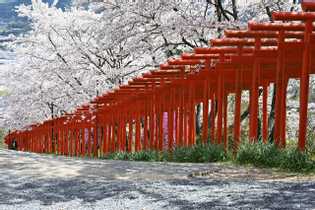花見 - Hanami (cherry blossom viewing)
Spring is the season of flowers in Japan. When spring comes, Japan is full of flowers of many hues and shapes, beautiful and colorful. The best known spring flower is the cherry blossom, which is called sakura in Japanese. The cherry blossom is the national flower of Japan, and the Japanese have traditionally enjoyed viewing cherry blossoms every year in the spring. This custom is called hanami in Japanese. When the cherry blossoms bloom, usually early in April, people go cherry blossom viewing. They spread straw mats under the cherry trees, sit there, and enjoy viewing the beautiful blossoms. People also enjoy eating many different kinds of food packed in lunch boxes, drinking sake, and singing. Hanami, therefore, looks like an outdoor party.
春は日本の四季のうちで最も華やかな季節です。この季節には、様々な色や形の無数の花が美しく色鮮やかに咲き乱れます。春の花で最も名高いのは桜です。桜は日本の国花で、日本人は春になると花見を行い、桜を観賞します。4月初旬頃に桜が開花すると、人々は花見に出かけます。この慣習は古くから行われてきました。花見客は桜の木の下にござを敷いて座り、花の美しさを十分に楽しみます。花を観賞するだけでなく、お弁当を食べたりお酒を飲んだりして、歌を歌いながら陽気に過ごします。そのような花見客の様子は、まるで屋外で宴会を開いているかのように見えます。
The custom of viewing cherry blossoms originated from a Buddhist ceremony that was performed by the court nobles in the twelfth century. It gained wide popularity in the seventeenth century although the religious aspect of the ceremony disappeared.
花見の慣習は12世紀頃、宮中の貴族の間で仏教儀式として始まりました。17世紀になると庶民の間に広まり、宗教的な意味はなくなりました。
The cherry blossoms only remain for a few days. This causes people to associate the changes in human life with the blossoms. These short-lived cherry blossoms also symbolized the ideals of Japanese militarism that glorified death in battle during the war. Death in battle, which was likened to the falling cherry blossoms, was regarded as beautiful at that time.
桜の開花期間はとても短く、わずか数日間咲いて散ってしまいます。このため、人生のはかなさを連想させる花でもあります。また、散りぎわが潔いということから、命を投げ出すという軍国主義精神を象徴する花でもありました。戦死が散っていく桜の花に喩えられ、美化されたのです。
Towards the end of March, the Meteorological Agency starts forecasting the days the cherry blossoms will bloom for each part of Japan. These forecasts are covered in the newspapers and on TV. These forecasts help people decide when and where to go cherry blossom viewing.
3月の終わり頃になると、気象庁は各地の桜が開花する日を予想して発表します。この予報は、テレビや新聞で報道されます。人々はそれを参考にして花見に出かける日や場所を決めます。
There are many kinds of cherry trees. Most of the cherry trees planted in parks and along dikes are someiyoshinos. Many of the cherry trees that grow wild in the mountains are yamazakuras. There are also many types of blossoms including the weeping cherry and the double-flowered cherry. Weeping cherries are called shidare-zakura in Japanese, and double-flowered cherries are yae-zakura. There are also a variety of blossom colors ranging from pale pink to reddish pink.
桜には色々な種類があります。公園や土手に植えられている桜のほとんどは、桜の代表とも言えるソメイヨシノです。山に自生している桜の多くはヤマザクラです。花の形も色々で、枝垂れや八重桜などがあります。色合いも薄いピンクや赤みの濃いものなど様々です。
The Japanese language has many idioms that are related to the cherry blossoms. The idioms hana-gumori and hana-bie both refer to the weather in the season when the cherry blossoms bloom. Hana-gumori means the cloudy weather in this season, and hana-bie means that the cold returns even though the flowers are already in bloom. The expression sakura-fubuki refers to petals of cherry blossoms falling and scattering like snowflakes in a snowstorm. The idiom hana-yori-dango literally means that people prefer dumplings (dango) to flowers (hana). This implies that the true purpose of viewing cherry blossoms is simply to enjoy drinking and eating.
日本語には、「桜」に関連する多くの表現があります。「花曇り」や「花冷え」は、桜が咲く頃の天候を表す表現です。「花曇り」はこの季節の曇り空、「花冷え」はこの時期にぶり返す寒さを表します。「桜吹雪(さくらふぶき)」は、桜が盛んに散る様子を表しています。「花より団子」は、多くの花見客が桜を観賞するという名目で飲んだり食べたりの宴会や大騒ぎを楽しむことを目的としていることを表します。
